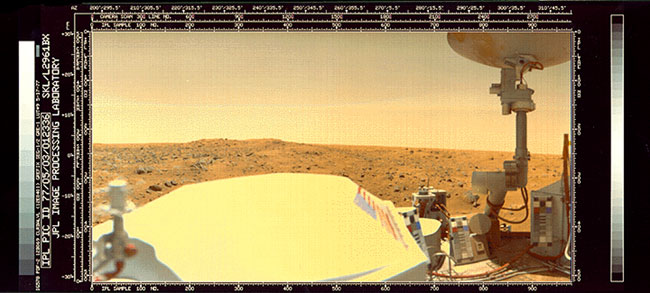Building Blocks for Life on Mars Possibly Seen By Viking Probes, Study Suggests

Samples ofMars dirt collected by NASA's Viking Mars landers back in the 1970s may have containedcarbon-based chemical building blocks of life as we know it, a new study suggests.
During theirmissions, the two Viking landers vaporized Martian dirt and scrutinized thesamples for signs of organic - or carbon-based - molecules that could serve asthe raw ingredients for life. At the time, all they found were chlorinecompounds attributed to contamination, but the new research suggests the Vikingprobes' heat-treatment may have generated these chlorine compounds fromnaturally occurring Martian organics, destroying them in the process.?
"Thisdoesn't say anything about the question of whether or not lifehas existed on Mars, but it could make a big difference in how we look forevidence to answer that question," study co-author Chris McKay, of NASA'sAmes Research Center in Moffett Field, Calif., said in a statement.
Organic moleculescan come from non-biological or biological sources. Meteorites raining on Mars andEarth for the past 5 billion years contain organics, so even if Mars has never supportedlife, scientists before the Viking missions expected Martian dirt to contain atleast some organics, researchers have said.
Newevidence from Phoenix
The newstudy follows a 2008 discovery made by the Phoenix Mars Lander. In its roughlyfive months on Mars, Phoenix found a chlorine-containing chemical calledperchlorate in the Martian dirt.
In the lab,the research team for the new study added perchlorate to some desert dirt fromChile that was known to contain organics. Then they heated the soil up,mimicking the Viking landers' organics-detection test. They found the same twoorganic chlorine compounds the Vikings did: chloromethane and dichloromethane.
Breaking space news, the latest updates on rocket launches, skywatching events and more!
What's theconnection between these three chemicals? Perchlorate becomes a strong oxidantwhen heated, breaking down naturally occurring organics into chloromethane anddichloromethane.
"Ourresults suggest that not only organics, but also perchlorate, may have beenpresent in the soil at both Viking landing sites," the study's leadauthor, Rafael Navarro-Gonz?lez of the National Autonomous University ofMexico, said in a statement.
"[Perchlorate]could sit there in the Martian soil with organics around it for billions ofyears and not break them down, but when you heat the soil to check fororganics, the perchlorate destroys them rapidly," McKay said.
Challengingold theories
The newstudy, in the current issue of the Journal of Geophysical Research ? Planets,may inspire scientists to reconsider the results of the Viking mission.
The Vikinglanders performed several different tests on Martian surface material in 1976.They found no compelling evidence for life, or even for the existence oforganic molecules.
Butsubsequent studies have questioned what these tests actually showed. Researchersreplicating Viking's methods on Earth, for example, failed todetect signs of life in Earth soil teeming with microbes.
More thanthree decades ago, the two Vikinglanders scooped up some Martian dirt and heated it to 500 degrees Celsius(932 degrees Fahrenheit). The chlorine compounds they found were interpreted atthe time as contaminants from cleaning fluids.
"Thelack of organics was a big surprise from the Vikings," McKay said."But for 30 years we were looking at a jigsaw puzzle with a piece missing.Phoenix has provided the missing piece: perchlorate. The perchlorate discoveryby Phoenix was one of the most important results from Mars since Viking."
Trying toresolve the question
UpcomingMars missions and further work on meteorites from Mars could help resolvewhether Viking actually found evidence of organics on the Red Planet.
Curiosity,a rover that NASA's Mars Science Laboratory mission will deliver to Mars in2012, will range far and wide, analyzing a broad range of rocks and dirtsamples. Its instruments will check for organics in Martian dirt and powderedrocks by baking samples to even higher temperatures than Viking did and byusing an alternative liquid-extraction method at much lower heat.
Combiningthese techniques on a range of samples may help test the new study's idea thatheated-up perchlorates could have destroyed organics in the Viking tests.
TheEuropean-led ExoMarsmission, set to launch in 2018, will include a rover with the ability todig about 6.5 feet (2 meters) below the Martian surface. The chances of findingcomplex molecules, including evidence of life such as proteins, are betterunderground, where molecules are protected from harsh ultraviolet radiation.
- Top 10 Mars Landings of All Time
- Gallery: Latest Mars Photos from Spirit and Opportunity
- Mud Volcanoes May Help Search for Life on Mars

Space.com is the premier source of space exploration, innovation and astronomy news, chronicling (and celebrating) humanity's ongoing expansion across the final frontier. Originally founded in 1999, Space.com is, and always has been, the passion of writers and editors who are space fans and also trained journalists. Our current news team consists of Editor-in-Chief Tariq Malik; Editor Hanneke Weitering, Senior Space Writer Mike Wall; Senior Writer Meghan Bartels; Senior Writer Chelsea Gohd, Senior Writer Tereza Pultarova and Staff Writer Alexander Cox, focusing on e-commerce. Senior Producer Steve Spaleta oversees our space videos, with Diana Whitcroft as our Social Media Editor.
